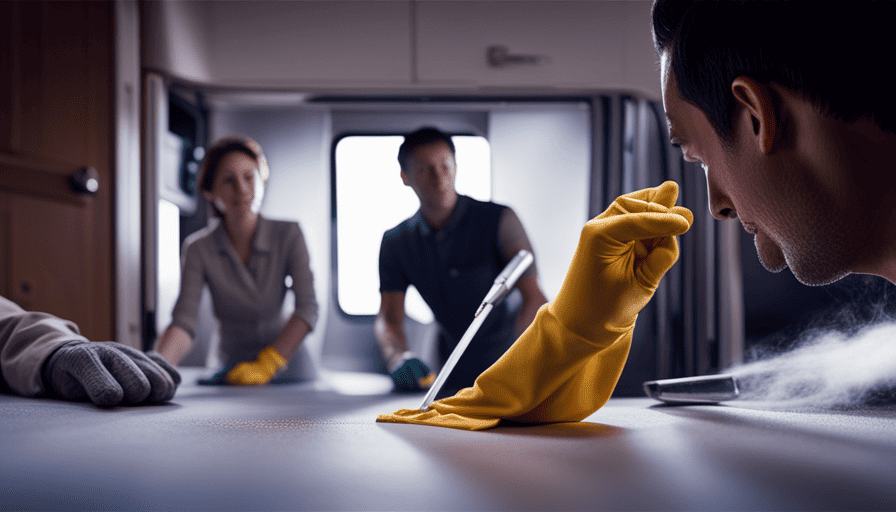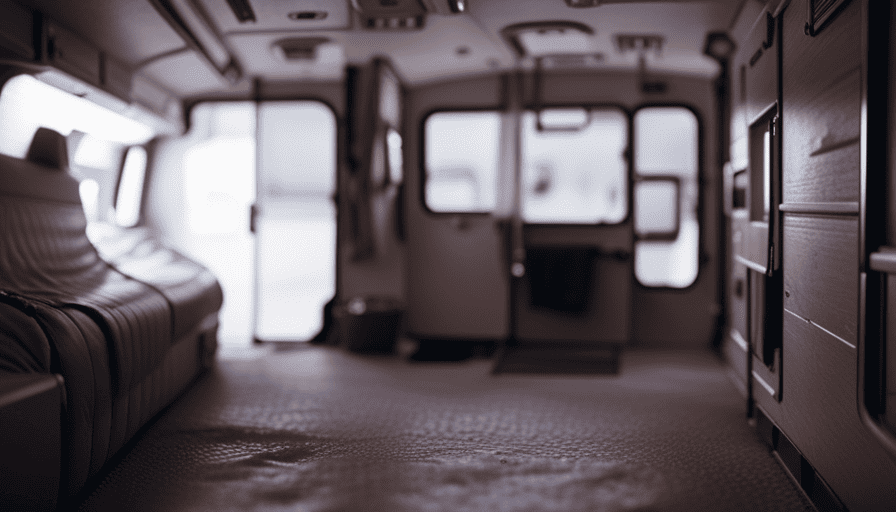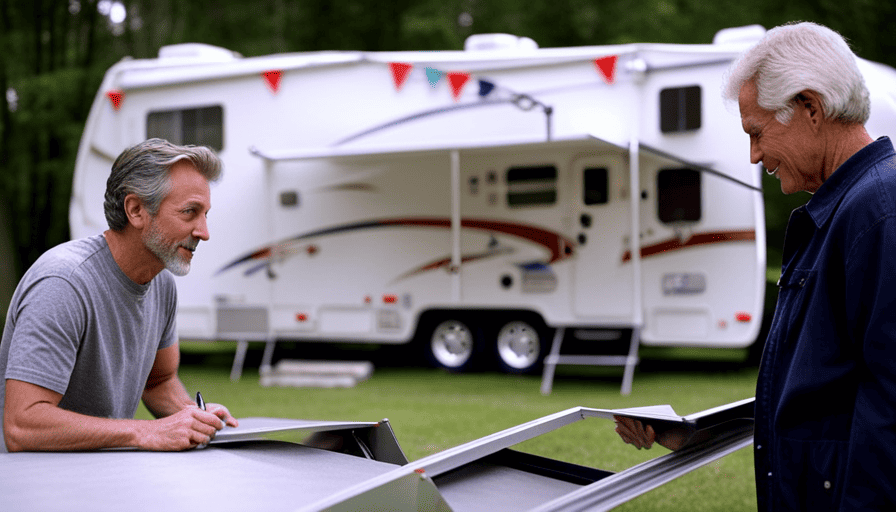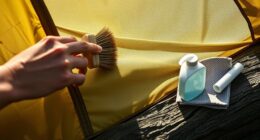Did you know that mold can grow in as little as 24-48 hours in damp environments? This is a common problem for camper owners. But fear not! I am here to offer you valuable tips on how to remove mold from your camper.
First things first, it’s important to identify the source of the mildew. Is it coming from a leaky roof or window? Once you’ve identified the problem, it’s crucial to remove any moisture sources. This might involve fixing any leaks or investing in a dehumidifier to reduce humidity.
Next, grab a mildew remover and give the affected area a thorough cleaning. If you prefer a natural alternative, vinegar works wonders as a mildew remover. Simply mix equal parts vinegar and water and scrub away with a brush or sponge.
To prevent future mildew growth, consider using a mildew inhibitor or preventative spray. It’s also important to regularly inspect and maintain your camper to catch any potential moisture issues early on.
Lastly, don’t forget about your fabrics and upholstery. Clean and dry them thoroughly to avoid any mildew growth.
By following these steps and staying proactive, you’ll be able to keep your camper mildew-free and ready for your next adventure!
Key Takeaways
- Identifying and fixing leaks in the camper’s roof and windows is crucial in preventing mildew growth.
- Using a dehumidifier or moisture absorbers can reduce humidity levels and prevent mildew.
- Regularly inspect and maintain the camper to catch moisture issues early on and prevent mildew growth.
- Clean and dry fabrics and upholstery thoroughly to prevent mildew growth.
Identify the Source of the Mildew
Now, let’s take a closer look and find out where that pesky mildew is coming from! Identifying the causes of mildew is crucial in preventing its growth.
One common source of mildew in campers is excessive moisture. It can enter the camper through leaks in the roof, windows, or doors. Check for any visible signs of water damage, such as discoloration or water stains. Pay close attention to areas that are prone to condensation, like the bathroom or kitchen.
Another cause of mildew is poor ventilation. Insufficient airflow can create a damp environment, perfect for mildew to thrive. Make sure all vents and fans are working properly and keep windows open whenever possible.
Additionally, check the camper’s plumbing system for any leaks or drips that could contribute to excess moisture.
By identifying these sources of mildew, you can take the necessary steps to remove any moisture sources and prevent further growth.
Remove any Moisture Sources
To effectively combat mildew in your camper, it’s crucial to eliminate all sources of moisture. Here are some moisture control strategies that will help prevent mold growth:
- Keep windows, doors, and vents properly sealed to prevent water from entering the camper.
- Use a dehumidifier or moisture absorbers to reduce humidity levels inside the camper.
- Make sure the camper is properly insulated to prevent condensation from forming on walls and ceilings.
- Check for any leaks in the plumbing system and repair them promptly.
- Avoid drying wet clothes or towels inside the camper, as this can introduce excess moisture.
By implementing these moisture control strategies, you can create an environment that’s less prone to mildew growth. Once you’ve removed all moisture sources, you can proceed to the next step of cleaning the area with a mildew remover.
Clean the Area with a Mildew Remover
Once you’ve eliminated all sources of moisture, it’s time to clean the area using a mildew remover, ensuring a fresh and mold-free environment in your camper.
When it comes to choosing a mildew remover, there are several options available. While bleach is a commonly used cleaner, it can be harsh and may damage certain surfaces. Instead, consider using alternative cleaners such as hydrogen peroxide or vinegar. These natural alternatives are effective in killing mildew and are safer for both your health and the environment.
To clean the affected area, start by wearing protective gloves and a mask to prevent any potential respiratory issues. Dilute the mildew remover according to the instructions on the product label. Apply the solution to the affected area and let it sit for a few minutes to allow it to penetrate the mildew. Using a scrub brush or sponge, gently scrub the area to remove the mildew stains. Rinse thoroughly with clean water and dry the area completely.
To prevent future mildew growth, ensure proper ventilation in your camper by opening windows or using fans to circulate air. Consider using dehumidifiers or moisture absorbers to control humidity levels. Regularly inspect and clean your camper to catch any moisture sources or potential mildew growth early on.
By following these steps, you can effectively clean the area using a mildew remover and prevent future mildew growth in your camper. Now, let’s discuss how to use vinegar as a natural mildew remover.
Use Vinegar as a Natural Mildew Remover
If you’re looking for a natural solution to eliminate mildew in your camper, look no further than vinegar. Not only is vinegar an effective mildew remover, but it also offers several benefits.
First, vinegar is readily available and affordable, making it a practical choice for camper owners. Second, it’s a non-toxic option, which is especially important if you have pets or children. Additionally, vinegar has antimicrobial properties, meaning it not only kills mildew but also inhibits its growth, preventing future infestations.
To use vinegar as a mildew remover, simply mix equal parts white vinegar and water in a spray bottle. Spray the solution onto the affected areas and let it sit for about 15 minutes. Then, scrub the surface with a brush or sponge to remove the mildew stains. Rinse the area thoroughly with water and dry it completely to prevent any residual moisture that may promote mildew regrowth.
While vinegar is a fantastic option, there are alternatives you can consider if you don’t have any on hand. Tea tree oil, hydrogen peroxide, and baking soda are all effective in removing mildew from surfaces. However, keep in mind that each alternative may require a different dilution ratio or application method.
Transitioning into the next section about scrubbing with a brush or sponge, it’s important to thoroughly clean the area to ensure the complete removal of mildew.
Scrub with a Brush or Sponge
Scrubbing with a brush or sponge is essential for effectively removing mildew stains from surfaces in your camper. When it comes to scrubbing techniques, it’s important to choose the right tools and products to get the job done efficiently. In my experience, I have found that using a stiff-bristled brush or a sponge with an abrasive side works best for tackling stubborn mildew stains.
To make the cleaning process more enjoyable, I like to imagine myself as a camper superhero, battling mildew and restoring the freshness of my camper. As I scrub away, I can almost feel the grime and mildew surrendering to my powerful strokes. To help you visualize the process, here’s a table that outlines my scrubbing techniques:
| Scrubbing Technique | Steps | Tips |
|---|---|---|
| Apply cleaning product | 1. Spray or apply the cleaning product directly onto the mildew stains. | Choose effective cleaning products such as vinegar or hydrogen peroxide. |
| Scrub in circular motion | 2. Use a brush or sponge to scrub the stains in a circular motion. | Apply gentle pressure to avoid damaging the surface. |
| Rinse and repeat if necessary | 3. Rinse off the cleaning product and inspect the area. Repeat the process if any stains remain. | Don’t forget to rinse thoroughly to remove any residue. |
Once you’ve finished scrubbing, it’s important to allow the area to dry completely before moving on to the next step. This will ensure that any remaining moisture is eliminated and prevent the growth of new mildew.
Allow the Area to Dry Completely
To fully enjoy the written content, it’s worth exploring whether the theory of allowing the area to dry completely holds true. When it comes to getting rid of mildew in your camper, preventing its growth is key. After scrubbing the affected area with a brush or sponge, it is essential to allow it to dry completely.
This step may seem simple, but it plays a crucial role in eliminating mildew and preventing its return. Proper ventilation is essential in the drying process. Open windows and doors to let fresh air circulate inside the camper. If weather permits, you can even set up fans to expedite the drying process. Ensure that all corners and crevices are well-ventilated to avoid any moisture buildup. Additionally, if you have access to an electrical outlet, you can use a portable dehumidifier to reduce humidity levels and aid in the drying process.
By allowing the area to dry completely, you are minimizing the chances of mildew regrowth. This step sets the foundation for the subsequent section on using a dehumidifier to further reduce humidity levels. Remember, thorough drying is a crucial part of the process to eliminate mildew from your camper effectively.
Use a Dehumidifier to Reduce Humidity
Properly ventilated, the camper buzzed with the hum of a dehumidifier, steadily reducing humidity levels and creating a dry environment. Using a dehumidifier is an effective way to combat mildew growth in your camper. Not only does it help to remove excess moisture from the air, but it also prevents the growth of mold and mildew. By controlling the humidity levels, you can significantly reduce the chances of mildew forming in your camper.
One of the main benefits of using a dehumidifier is that it helps to create a comfortable living environment. Excessive humidity can make the air feel heavy and damp, leading to discomfort and unpleasant odors. By using a dehumidifier, you can maintain a more pleasant atmosphere inside your camper.
While using a dehumidifier is an effective method, there are also alternative ways to remove mildew from your camper. Some people prefer to use natural remedies like vinegar or tea tree oil to kill mildew. These methods can be effective, but they may not be as powerful as a dehumidifier in preventing future growth.
In the next section, we will discuss another method to combat mildew in your camper: using a mildew inhibitor or preventative spray. By incorporating this step into your routine maintenance, you can further protect your camper from the harmful effects of mildew.
Use a Mildew Inhibitor or Preventative Spray
Don’t let mildew take hold in your camper; ward it off with the powerful protection of a mildew inhibitor or preventative spray. When it comes to preventing mildew, taking proactive measures is key. Alongside using a dehumidifier to reduce humidity, using a mildew inhibitor or preventative spray can further safeguard your camper from this pesky fungus. These products provide an extra layer of defense against mildew growth, ensuring a clean and fresh environment.
To give you a clear understanding of how effective these measures can be, imagine this: on one side of a table, you have a surface treated with a mildew inhibitor, while on the other side, you have an untreated surface. The treated side remains immaculate, while the untreated side becomes a breeding ground for mildew. This visual representation highlights the importance of using preventative measures to combat mildew in your camper.
In addition to using a mildew inhibitor or preventative spray, there are alternative treatments you can explore. Natural remedies such as vinegar, tea tree oil, or hydrogen peroxide can also help inhibit mildew growth. These options provide a more eco-friendly approach, and they are often readily available in most households.
Now that you understand the importance of preventative measures and alternative treatments, let’s move on to the next step: ensuring clean and dry fabrics and upholstery.
Clean and Dry Fabrics and Upholstery
Ensure your fabrics and upholstery stay clean and dry, creating a cozy and inviting atmosphere that will make you never want to leave your camper.
One effective way to keep your fabrics and upholstery in top condition is by regularly cleaning and drying them. When it comes to fabrics, it’s important to follow the manufacturer’s instructions for cleaning. Some fabrics may require dry cleaning, while others can be safely washed in a machine. Be sure to use the appropriate cleaning products and techniques to avoid damaging the fabric.
For upholstery, consider hiring a professional upholstery cleaning service. They have the expertise and equipment to thoroughly clean your upholstery and remove any mildew or odors. Professional cleaning can also help extend the lifespan of your upholstery, keeping it looking fresh and new.
After cleaning, ensure that your fabrics and upholstery are completely dry before putting them back in your camper. Moisture can lead to the growth of mildew and mold, so it’s important to air dry them or use a fan to speed up the drying process. This will help prevent any future mildew issues.
Regularly inspect and maintain your camper to ensure that it remains in good condition. By following these simple steps, you can keep your camper clean and free from mildew, creating a comfortable and enjoyable living space for all your adventures.
Regularly Inspect and Maintain your Camper
Regularly inspecting and maintaining your camper is essential for preventing costly repairs and ensuring a safe and enjoyable camping experience. Did you know that 85% of camper owners who regularly inspect and maintain their vehicles have fewer breakdowns on the road? By following some simple steps, you can keep your camper in top shape and avoid the growth of mildew.
One important aspect of camper maintenance is inspecting for leaks. Make it a habit to regularly check all windows, doors, and seams for any signs of water intrusion. Even the smallest crack can lead to significant water damage and the growth of mildew. Repair any leaks promptly to prevent further damage.
Another area to focus on is ventilation. Proper airflow is crucial in preventing the buildup of moisture, which can contribute to the growth of mildew. Regularly check the ventilation system in your camper, including the roof vents and fans, to ensure they are functioning correctly. Clean or replace filters as needed to maintain optimal airflow.
To help you stay on top of your camper maintenance, here is a table summarizing the key areas to inspect and maintain:
| Area to Inspect | Maintenance Tasks |
|---|---|
| Windows | Check for leaks |
| Doors | Inspect for cracks |
| Seams | Repair any damage |
| Roof Vents | Clean and check |
| Fans | Ensure proper function |
| Filters | Clean or replace as needed |
Taking the time to regularly inspect and maintain your camper will not only help prevent the growth of mildew but also extend the life of your vehicle. By staying proactive, you can enjoy worry-free camping adventures for years to come.
Frequently Asked Questions
How long does it take for the area to dry completely after using a mildew remover?
After using a mildew remover, the area usually takes about 24 to 48 hours to dry completely. To prevent mildew from forming in the first place, it’s important to keep your camper well-ventilated and dry. Open windows and vents to promote air circulation, and use a dehumidifier if necessary.
After using a mildew remover, make sure to thoroughly dry the area by using fans or leaving windows open. This will help prevent any moisture from lingering and causing mildew to return.
Can I use bleach instead of a mildew remover to clean the area?
Yes, you can use bleach instead of a mildew remover to clean the area. Bleach is an effective and affordable option for killing mildew and removing stains. However, it’s important to dilute the bleach with water before using it, as it can be harsh on certain surfaces.
To prevent mildew in your camper, ensure proper ventilation, keep the area clean and dry, and consider using a dehumidifier or moisture absorber.
Are there any specific types of brushes or sponges that work best for scrubbing mildew?
When it comes to scrubbing mildew, it’s important to use the right tools. I recommend using a stiff-bristled brush or a sponge with an abrasive surface. These types of brushes and sponges are effective at removing mildew from surfaces.
Additionally, proper ventilation is crucial for preventing mildew growth. Make sure to keep your camper well-ventilated to reduce moisture levels and minimize the chances of mildew forming.
How often should I use vinegar as a natural mildew remover?
To prevent mildew growth in your camper, it’s recommended to use vinegar as a natural mildew remover regularly. I suggest using vinegar once a week or whenever you notice mildew starting to form.
Additionally, there are alternative natural remedies for removing mildew in campers, such as hydrogen peroxide, tea tree oil, or baking soda. These options can be effective in eliminating mildew and preventing its return.
Regular cleaning and proper ventilation are also essential for keeping mildew at bay.
Are there any specific brands of mildew inhibitors or preventative sprays that are recommended for campers?
I recommend using mildew inhibitors and preventative sprays specifically designed for campers. These products are often formulated to effectively prevent the growth of mildew in the unique environment of a camper.
Some popular brands include XZ-12 Mildew Inhibitor and CamperGuard Mildew Preventative Spray. These products are easy to use and can provide long-lasting protection against mildew.
Regularly applying these inhibitors and sprays can help keep your camper free from mildew and maintain a clean and fresh environment.
Can Mildew in the Camper Cause the Toilet to Smell?
Yes, mildew in the camper can cause the toilet to smell. If the mildew is present in the bathroom or near the toilet, it can release a musty odor that can make the toilet smell bad. Proper cleaning and ventilation are essential for keeping camper toilet smelling fresh and preventing mildew growth.
Conclusion
After following these steps, I was able to successfully get rid of the mildew in my camper. It was a bit of a process, but it’s well worth it to have a clean and fresh-smelling living space.
One interesting statistic that I came across during my research is that mildew can grow and spread within 24 to 48 hours in a damp environment. This alarming fact really emphasizes the importance of regularly inspecting and maintaining your camper to prevent mildew growth.











